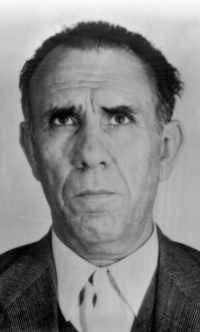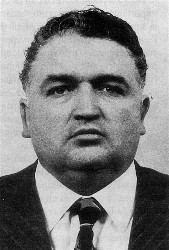Births
| | This section is empty. You can help by adding to it. (July 2010) |
| |||
|---|---|---|---|
| +... |
| | This section is empty. You can help by adding to it. (July 2010) |

Gaetano Badalamenti was a powerful member of the Sicilian Mafia. Don Tano Badalamenti was the capofamiglia of his hometown Cinisi, Sicily, and headed the Sicilian Mafia Commission in the 1970s. In 1987, he was sentenced in the United States to 45 years in federal prison for being one of the leaders in the "Pizza Connection", a $1.65 billion drug-trafficking ring that used pizzerias as fronts to distribute heroin from 1975 to 1984. He was also sentenced in Italy to life imprisonment in 2002 for the 1978 murder of Peppino Impastato.

Stefano Bontade, born Stefano Bontate, was a powerful member of the Sicilian Mafia. He was the boss of the Santa Maria di Gesù Family in Palermo. He was also known as the Principe di Villagrazia − the area of Palermo he controlled − and Il Falco. He had links with several powerful politicians in Sicily, and with prime minister Giulio Andreotti. In 1981 he was killed by the rival faction within Cosa Nostra, the Corleonesi. His death sparked a brutal Mafia War that left several hundred mafiosi dead.

Michele Greco was a member of the Sicilian Mafia and a convicted murderer. Greco died in prison while serving multiple life sentences. His nickname was Il Papa due to his ability to mediate between different Mafia families. Greco was the head of the Sicilian Mafia Commission.
The Sicilian Mafia Commission, known as Commissione or Cupola, is a body of leading Sicilian Mafia members who decide on important questions concerning the actions of, and settling disputes within the Sicilian Mafia or Cosa Nostra. It is composed of representatives of a mandamento who are called capo mandamento or rappresentante. The Commission is not a central government of the Mafia, but a representative mechanism for consultation of independent Mafia families who decide by consensus. Its primary role is to keep the use of violence among families within limits tolerable to the public and political authorities.

Giuseppe Di Cristina was a powerful mafioso from Riesi in the province of Caltanissetta, Sicily, southern Italy. Di Cristina, nicknamed “la tigre’men of honour as well.
The 1960s Sicilian Mafia trials took place at the end of that decade in response to a rise in organized crime violence around the late 1950s and early 1960s. There were three major trials, each featuring multiple defendants, that saw hundreds of alleged Mafiosi on trial for dozens of crimes. From the authority's point of view, they were a failure; very few defendants were convicted, although later trials as well as information from pentiti confirmed most of those acquitted were Mafiosi members, and were guilty of many crimes including some of those they were acquitted of.

Giuseppe “Pippo” Calderone was an influential Sicilian mafioso from Catania, eventually becoming the capo of the Catania Mafia family.
The Second Mafia War was a period of conflict involving the Sicilian Mafia, mostly taking place from 1981 to 1984 and involved thousands of homicides. Sometimes referred to as The Great Mafia War or the Mattanza, it involved the entire Mafia and radically altered the power balance within the organization. In addition to the violence within the Mafia itself, there was violence against the state, including a campaign of deliberate assassinations of judges, prosecutors, detectives, politicians, activists and other ideological enemies. In turn, the war resulted in a major crackdown against the Mafia, helped by the pentiti, Mafiosi who collaborated with the authorities after losing so many friends and relatives to the fighting. In effect, the conflict helped end the secrecy of the Mafia.

The Greco Mafia family is historically one of the most influential Mafia clans in Sicily, from the late 19th century. The extended family ruled both in Ciaculli and Croceverde Giardini, two south-eastern outskirts of Palermo in the citrus growing area. Members of the family were important figures in the Sicilian Cosa Nostra. Salvatore "Ciaschiteddu" Greco was the first ‘secretary’ of the Sicilian Mafia Commission, while Michele Greco, also known as The Pope, was one of his successors.

The Viale Lazio massacre on 10 December 1969 was a settling of accounts in the Sicilian Mafia. Mafia boss Michele Cavataio and three men were killed in the Viale Lazio in Palermo, Sicily, by a Mafia hit squad. The bloodbath marked the end of a pax mafiosa that had reigned since the Ciaculli massacre until the end of the Trial of the 114 against Cosa Nostra.
The Genovese crime family's New Jersey faction is a group of Italian-American mobsters within the Genovese crime family who control organized crime activities within the state of New Jersey. The New Jersey faction is divided into multiple crews each led by a different caporegime who oversees illegal criminal activities in labor racketeering, illegal gambling, loansharking and extortion. The Genovese crime family's New Jersey faction has maintained a strong presence in the Northern Jersey area since the early prohibition era. A number of powerful mobsters within the New Jersey faction such as Guarino "Willie" Moretti, Gerardo "Jerry" Catena and Louis "Bobby" Manna have each held positions within the Genovese family's administration. From the 1990s until his death in 2010, Tino "the Greek" Fiumara was one of the most powerful caporegimes in the New Jersey faction.

Giuseppe Greco was a hitman and high-ranking member of the Sicilian Mafia. A number of sources refer to him exclusively as Pino Greco, although Giuseppe was his Christian name; Pino is a frequent abbreviation of the name Giuseppe.
The Bonanno crime family is an Italian-American Mafia crime family and one of the "Five Families" that dominate organized crime activities in New York City as part of the criminal phenomenon known as the American Mafia.
This is a list of organized crime in the 1950s, arranged chronologically.